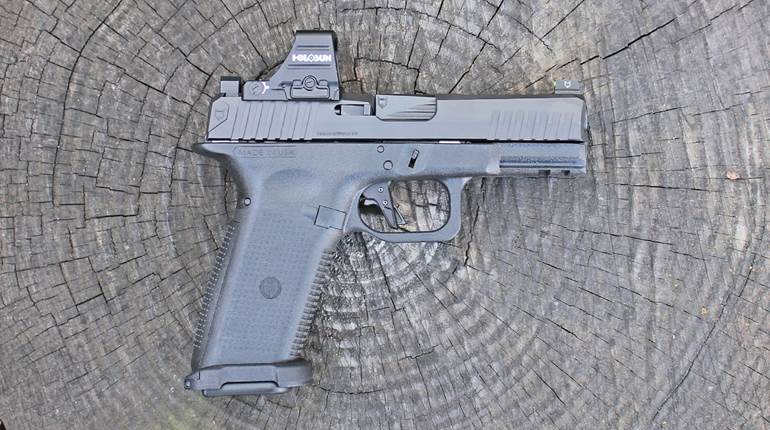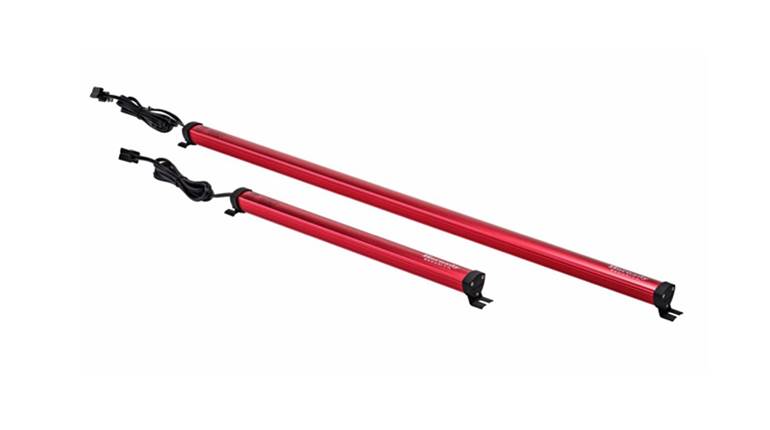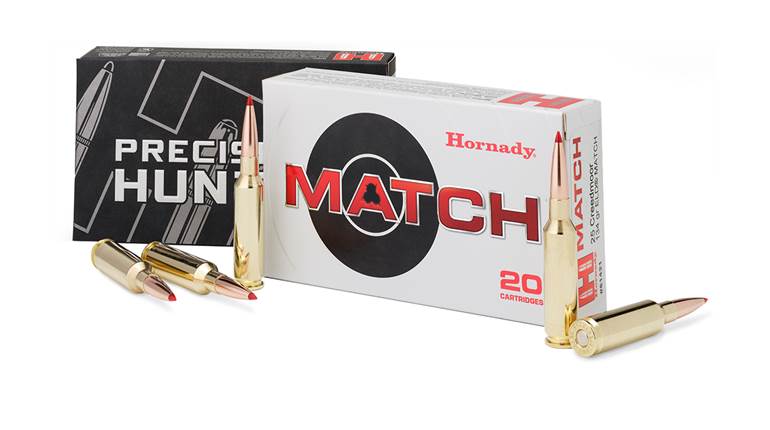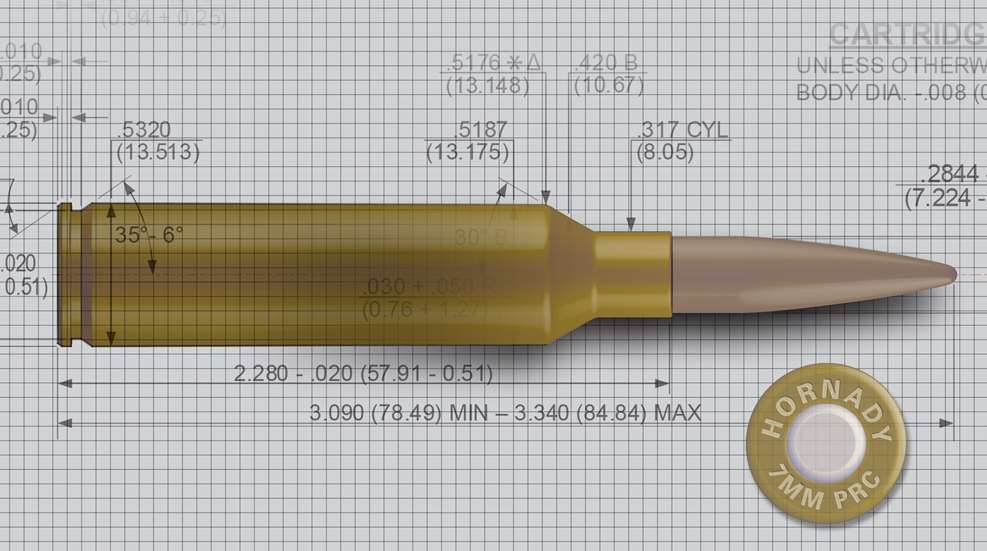
Before I dive into reporting on the new Hornady 7 mm PRC (hornady.com), let’s get one thing straight: Contrary to accepted wisdom, new chamberings don’t necessarily have to fill an unoccupied “slot.” Though an argument can nearly always be made for such, what really matters is what the “new kid” can do and how that resonates with customers to create demand.
As their growing Precision Rifle Cartridge family shows, Steve and Jason Hornady—probably better than anyone since Roy Weatherby—understand this free-market maxim: Build it to excel in trending firearms, and shooters will clamor for more. Doing so, their Nebraska-based ammunition incubator has normalized the advantages of driving elongated, high-ballistic-coefficient (BC) bullets via faster rifling twists. For those in the know, 1,000 yards is the new 500.
On the heels of the successful 6.5 mm PRC (2018) and the much-praised (albeit underappreciated) .300 PRC (2021), the 7 mm entry emphasizes both power and shootability and thus represents a compromise. True to form, this latest 7 mm delivers 20 percent more energy than its 6.5 mm predecessor with three-quarters the kick of the .300, the kind of balancing act responsible for attracting legions to the in-between bore.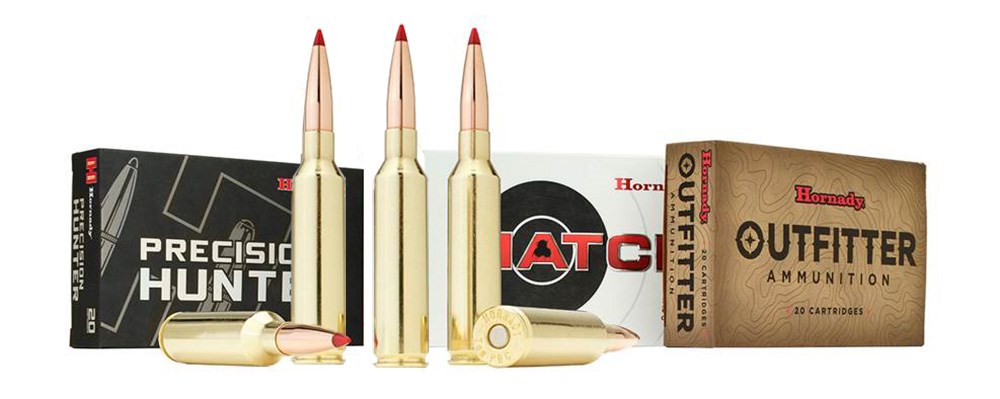
Specs In Context
As shown in the table nearby, the 7 mm PRC isn’t quite a ballistic outlier, as there’s overlap in key performance metrics with other “super 7s.” Apart from twist rate, it’s not the fastest, flattest-shooting, hardest-hitting or softest-recoiling, but it notably rates high across the board. Dig a bit deeper, and what materializes is a cartridge uniquely groomed for long-range efficiency.
Attaining greater velocity from less propellant has been a holy grail for ammunition developers since the mega-magnum heyday. In theory, at least, that leads to greater consistency (accuracy). Hornady’s approach somewhat reversed the order, according to what I learned from Joe Thielen, Jayden Quinlan and Seth Swerczek, part of the team that created the new cartridge. They identified efficiencies in both case and projectile designs that prioritize accuracy potential while also achieving end goals of flatter trajectory, more effective energy transfer and less wind deflection, without relying just on raw velocity. It’s a blueprint that’s caused a stir in long-range circles ever since a routine Sporting Arms and Ammunition Manufacturers Institute (SAAMI) posting last June leaked the 7 mm PRC’s specs.
To get acquainted, let’s start with overall length (OAL), which, at 3.340", is the same as .270 Win. and .30-’06 Sprg., thus allowing the new cartridge to fit familiar standard-length actions. That length, nonetheless, is utilized differently, as the case body measures 2.28"—about 10 percent shorter than the old-timers. That resulting chamber “real estate” has been re-allocated to bullet length in keeping with the distinct PRC family profile and indicative of the line’s long-range mission. As such, it stands out as the only SAAMI-approved 7 mm/0.284" currently offering both a 1:8" twist rate and a chamber throat long enough for today’s long-ogive, heavy-for-caliber, ultra-BC bullets.
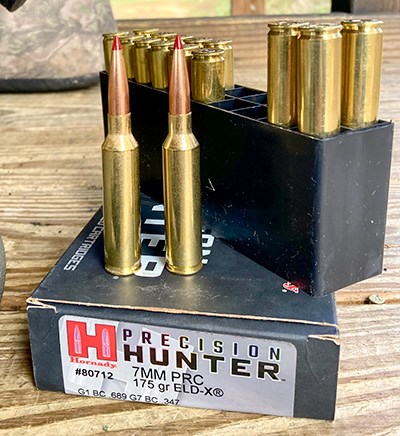 The .270 and .30-’06 aren’t cycling such aerodynamic projectiles without yielding powder capacity and muzzle velocity. Thanks to an extra 1/4" of body length, the 7 mm Rem. Mag. is nearly as fast at the muzzle, but it lags out yonder because its chamber dimension and slower rifling (1:9.5") likewise limit it to shorter bullets with lower BCs. In Hornady’s Precision Hunter line, for example, the Remington cartridge tops out with a 162-grain ELD-X versus the 7 mm PRC’s 175-grain ELD-X.
The .270 and .30-’06 aren’t cycling such aerodynamic projectiles without yielding powder capacity and muzzle velocity. Thanks to an extra 1/4" of body length, the 7 mm Rem. Mag. is nearly as fast at the muzzle, but it lags out yonder because its chamber dimension and slower rifling (1:9.5") likewise limit it to shorter bullets with lower BCs. In Hornady’s Precision Hunter line, for example, the Remington cartridge tops out with a 162-grain ELD-X versus the 7 mm PRC’s 175-grain ELD-X.
The “parent” case comes from the .375 Ruger, a Ruger-Hornady dangerous-game thumper that debuted shortly before another newbie hogged the spotlight, namely the 6.5 mm Creedmoor.
The Creedmoor phenomenon is now extrapolated in the PRCs. Following a similar development track, they use non-belted cases that headspace on a 30-degree shoulder. The stature falls between short-fat and full-length magnum, but what’s most striking is the span of bullet extending from the case neck. In that regard, the Creedmoor emerged in 2007 as one of three long-necked 6.5 mm wildcats-turned-factory offerings, and now the PRCs take it up a notch. The 7 mm PRC’s specs call for more than an inch of exposed bullet, nearly 32 percent of its OAL, markedly greater than any commonly used big-game cartridge developed in the U.S. The Hornady engineers touted this move to “get the bullet out of the case.”
“There’s a major advantage over the majority of designs from the early 2000s and older with bullets seated way down into the case body,” explained Quinlan. “We’ve learned that how the bullet is handed off from contact with the case neck into the rifling has a huge impact on group-size capability. Besides the obvious benefit of not robbing powder capacity, it helps make that handoff more consistent. In most cases, the best seating depth is where the bearing surface-boattail junction aligns with the case’s neck-shoulder junction.”
The 7 mm PRC’s relatively short, fat case body gradually tapers from its 0.532" base to 0.5176" at the shoulder. It’s a design known for propellant-burning consistency compared to elongated bodies with excess powder capacity, a track record that promises optimum accuracy plus longer barrel life and reduced muzzle blast. True to PRC genetics, SAAMI drawings for the 7 mm also show a minimal 0.2846" freebore diameter, which virtually eliminates any chance of bullet yaw before it touches the rifling. SAAMI max pressure rated at 65,000 p.s.i., it equals many recent introductions, including the other PRCs. The case head diameter is 0.532", making it compatible with myriad standard-action rifles possessing 0.540" bolt faces. Not only a manufacturing efficiency, that means many existing sporters in 7 mm Rem. Mag., .300 Win. Mag. and other chamberings could be converted simply by rebarreling.
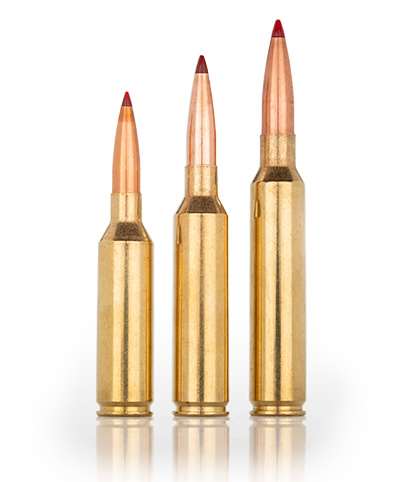
Load Selection
To begin, Hornady is producing three loads, one geared for competition, the others for hunting. Engineered to excel at specialized assignments, especially at extended ranges, all of them boast signature bullets tipped with the firm’s breakthrough Heat Shield non-deforming tip. Hornady’s Seth Swerczek stressed, however, “We don’t rely so much on velocity to do the work, but more so on the bullets’ built-in efficiency.”
Match 180-grain ELD Match (G1 BC: 0.796; G7 BC: 0.401)—A precise jacket taper is one key element in ensuring the superior concentricity this bullet needs to rack up hits out past 1,000 yards. Its off-the-chart BCs and Heat Shield tip have combined to re-define long-range precision.
Precision Hunter 175-grain ELD-X (G1 BC: 0.689; G7 BC: 0.347)—Across numerous calibers, the ELD-X has reset standards for superb accuracy and reliable terminal expansion over a broad span of hunting ranges. Its secant ogive, boattail and bearing-surface length are nearly identical to the Match bullet’s, but it’s a bit longer since the jacket taper and base are thicker. Swerczek noted, “The ELD-X is one of the most technical bullets we make. Lots of processes are involved to ensure jacket concentricity plus getting the taper and InterLock right.”
Outfitter CX 160-grain (G1 BC: 0.596; G7 BC: 0.300)—For hunters who want a more deliberate expansion footprint and retained weight over 95 percent, the company has updated its first-gen all-copper GMX with the new CX line. Said Swerczek, “This 160-grain version for the 7 mm PRC is as slippery as you can make such bullets—there’s nothing else even close. You don’t give up anything [in flat trajectory], and you get all the terminal-performance benefits.”
Observations
At first blush, the 7 mm PRC is what I’d call “snappy.” The recoil is substantial, but not punishing. Typical of this category, the more I shot, the more I felt it. Hunters experienced with legacy 7 mms or .30-cals. and who typically fire a box or so per practice session should have little problem. The loaded question is how it’ll click with competitors bearing down on 80-shot courses of fire over a few hours.
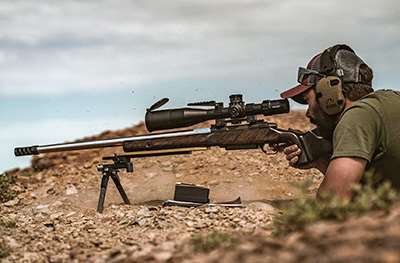
Seeing my first groups knot up downrange made it easier to cope with the kick. And, mind you, the bearer of these impressions was an economical, sporter-weight Mossberg Patriot Predator. Likely, both takeaways would have been even better were I shooting a heavy-barreled, form-fitting tack-driver, but over the course of more bench shooting, gong ringing and a great introductory hunt, the Mossberg continually outperformed its price class. While groups hovering around minute of angle won’t intrigue today’s discerning shooters, let’s not overlook the utility of such everyman rigs. My gong show at 200 and 400 yards was especially fun and gave me the chance to employ a load-specific Custom Dial System turret on the rifle’s Leupold VX-6HD optic. I missed a couple of times at first, then got in a groove, and by the time the drill had consumed the entire box of 175-grain ELD-Xs, it was clear the plates were too close.
Shooters focused on far more challenging targets have been scoring hits as well. Swerczek reported good news from last fall’s Nightforce ELR Match in Wyoming, where a handful of competitors debuted the 7 mm PRC over a course consisting mostly of target engagements at 1,000 yards and farther. “It allowed them to actually spot their own shots, to see dirt splash up on misses, without giving up any exterior ballistics to the heavy-recoiling .338s and .375s many use,” he said. A long-range shooter himself, Swerczek feels the 7 mm PRC, “will deliver more recoil than most shooters want in sports like Precision Rifle Series. However, in Extreme Long Range (ELR), it will definitely be a top contender.”
Even so, Hornady has chiefly promoted 7 mm PRC as a hunting round, and the early results have been bullish. One friend who center-punched a hefty Canada moose told me later, “If I hit a deer like that, it’s going to run 40 yards, but that bull just turned, took two steps, then crashed.” That echoed what I witnessed during a shakedown expedition to South Africa—see the accompanying sidebar for further details on results and the gear we used. Suffice it to say, our hopes for a dream safari were too modest.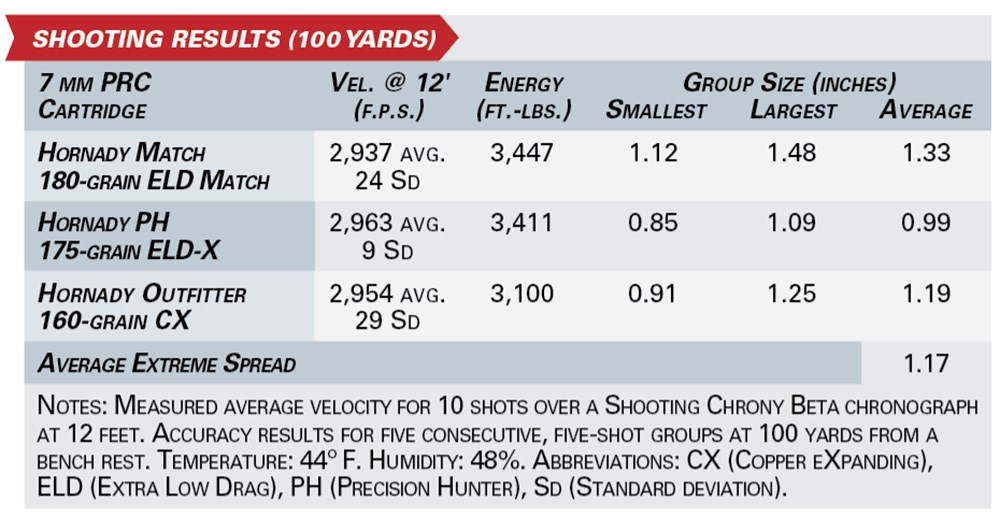
The Wrap
The 7 mm PRC deserves lots of attention, regardless of what “need” it might fill for you. The milder 6.5 mm PRC drops a bit faster downrange and delivers less energy from slightly lighter bullets. Other 21st century 7 mms are a step or half-step behind in their ability to stabilize the highest-BC bullets, but a half-step ahead in other areas. The tried-and-true 7 mm Rem. Mag., likewise, can’t quite match 7 mm PRC capabilities, but for as close as it is, the sheer availability of rifles and loads will keep it relevant. All that aside, I think a pair of other factors will be the key to determining the new PRC’s future prospects.
Technology rarely goes in reverse. Ultra-BC bullets are an innovation whose time has come. Their advantages in flat trajectory, bucking the wind and downrange knockdown may be moot in many hunting applications, but the same was true when jacketed bullets replaced lead slugs, when spitzers and tipped bullets made round noses obsolete and, to a lesser extent, when controlled-expansion designs raised the bar over the standard cup-and-core types. Regardless of how it may or may not benefit us personally, the shooting public has been keen to embrace rising ammo technology. Affordability remains a factor, but as often as not, innovative manufacturers have found willing markets.
Also, we like straight shooters. In the case of the 6.5 mm Creedmoor’s landslide popularity, I’m convinced it’s less about ballistic assets than the fact that it shoots so darn well in virtually any rifle chambered for it. Across the pricing spectrum, bolt-actions, ARs, single-shots and even lever-actions in 6.5 mm Creedmoor have provided operators self-validating experiences. Isn’t that what shooters really want?
On a narrower scale, the 6.5 mm PRC appears to be cut from similar cloth. Because of the 7 mm PRC’s stouter recoil, it’s unlikely to duplicate such universal acclaim, but if it proves nearly as adaptable and accurate in all or most rifles, it’ll be around for a long time. It might even help narrow the preference gap between 7 mms and long-dominant .30-cals.

Rifles Chambered For 7 mm PRC
Time was, the biggest ammunition companies were also the biggest gun companies, so new-cartridge rollouts were coordinated affairs. As that setup waned, firearm partners had to be enlisted to ensure a brand or two were in the works when the ammunition started shipping. Availability was spotty at times, but the market seems to have adapted, and given Hornady’s “Midas touch” with the PRC line and the 6.5 mm Creedmoor, prospective 7 mm PRC owners already have a wealth of options. Household names and custom makers alike are selling rifles (or soon will be), which run the gamut in pricing and features, including: AllTerra Arms, Browning, Christensen Arms, Gunwerks, Hill Country Rifles, H-S Precision, Mossberg, Proof Research, Ruger, Savage and Seekins Precision. There are not many product categories where enthusiasts on tight budgets can afford the latest and best technology in existence, but this is one.












